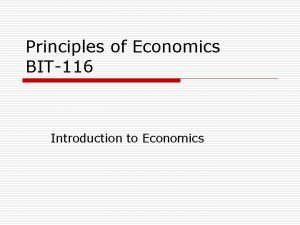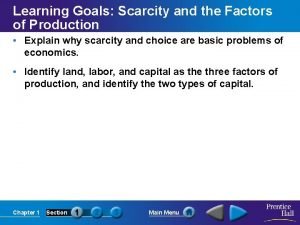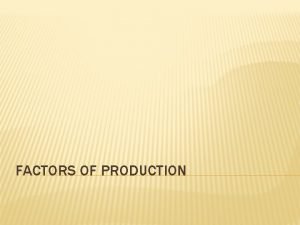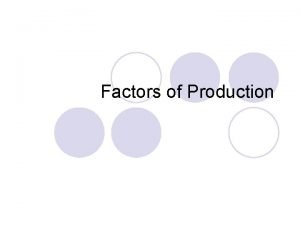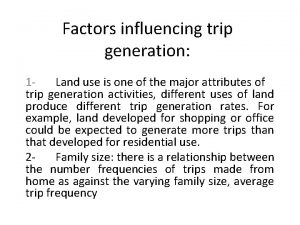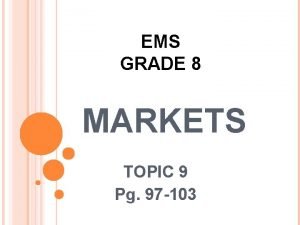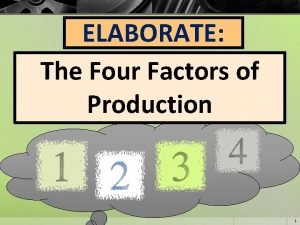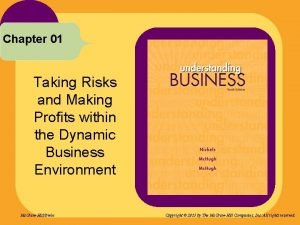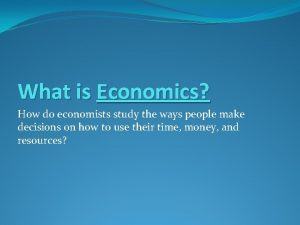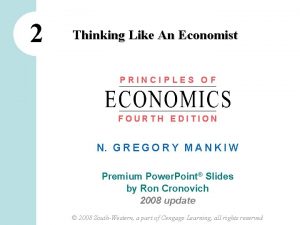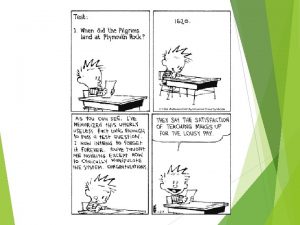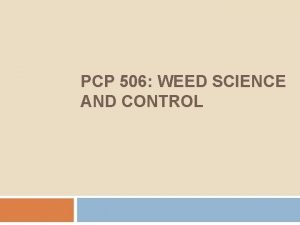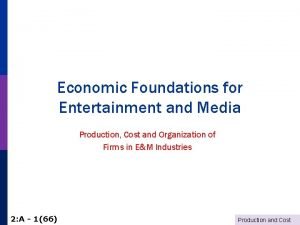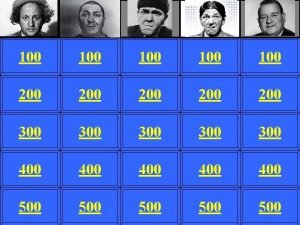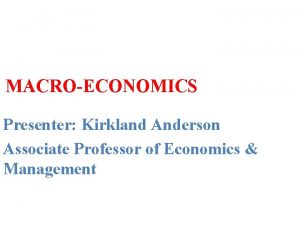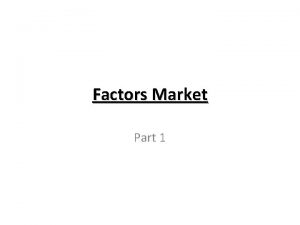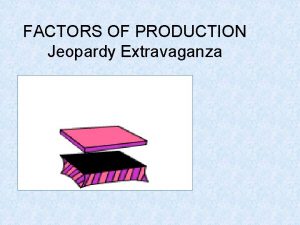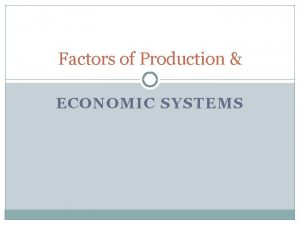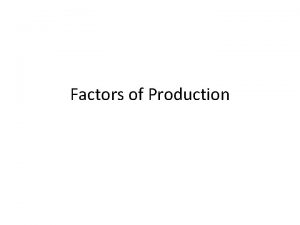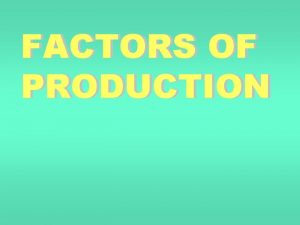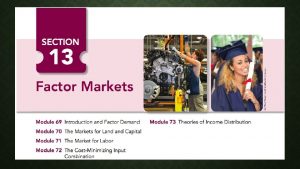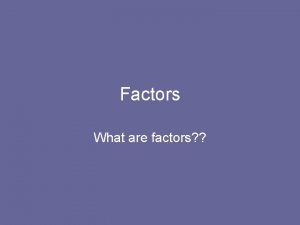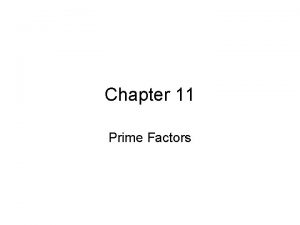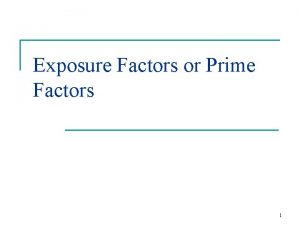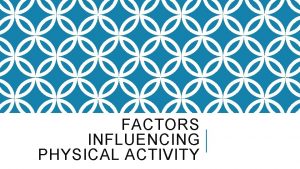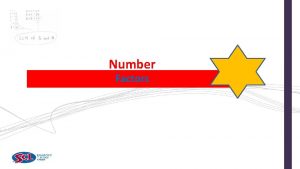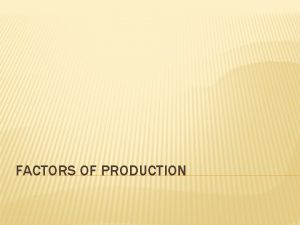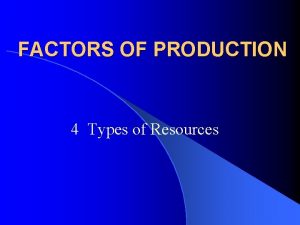FACTORS OF PRODUCTION REVIEW FACTORS OF PRODUCTION Factors

























- Slides: 25

FACTORS OF PRODUCTION

REVIEW: FACTORS OF PRODUCTION • Factors of production is an economic term that describes the inputs that are used in the production of goods or services in order to make an economic profit. The factors of production include: • Land; includes all natural resources • Labour; includes all human resources • Capital; includes all man-made resources • Entreprenuership; brings all resources together for production

LAND: WHO OWNS IT? • Nobody: held in common, used by anyone • Everybody: held collectively, mutually decide use • Individually: held privately, individual decisions

THEORIES OF OWNERSHIP: ARISTOTLE, 384 -322 BCE • Greek Philosopher, student of Plato & teacher of Alexander the Great • Founder of practical, hands-on science & process. • “Time crumbles things; everything grows old under the power of Time and is forgotten through the lapse of Time. ”

ARISTOTLE’S THEORY OF OWNERSHIP No one maintains it When Property is held in common Little incentiv e to invest Ergo: Property should be private It prevents generosit y

LAND: INDUSTRIAL REVOLUTION ENCLOSURE • As farming practices were modernized and became more efficient, the Agricultural Revolution ended communal use of open fields by providing incentive to “enclose” land for individual use • Created landless working class, freed up to work in the new factories • Land previously owned by Crown or Church

PRIVATE PROPERTY: FOUNDATION OF CAPITALISM, BUT IS IT THE BEST SYSTEM IN WHICH TO ORGANIZE LAND? YES NO • Aristotle: morally superior • Karl Marx: system to perpetuate slavery (benefits only the rich) • John Locke: provided opportunities for the individual • Immanual Kant: form of self expression • Tragedy of the Commons • Widening gap between the “haves” and “have nots”

LABOUR:

THEORIES OF LABOUR: FRANCOIS QUESNAY 4 June 1694 – 16 December 1774, was a French economist and physician of the Physiocratic school. He is known for publishing the "Tableau économique" (Economic Table) in 1758, which provided the foundations of the ideas of the Physiocrats. This was perhaps the first work attempting to describe the workings of the economy in an analytical way, and as such can be viewed as one of the first important contributions to economic thought. His Le Despotisme de la Chine, written in 1767, describes Chinese politics and society, and his own political support for constitutional Oriental despotism.

THEORIES OF LABOUR: FRANCOIS QUESNAY, 1694 -1774 • French physician, started as the son of a plowman, transitioned to apprenticeship in engraving before settling in University • Specialized in treating the Nobility (lived at Versaille) • Wrote the Economic Table, founder of Les Economistes

QUESNEY’S ECONOMIC TABLE • Agricultural sources = wealth, NOT trade and industry • Economic flow (rent, wages, purchases) is the real driver of the economy • Taxes should be eased on productive elements (workers) and increased on the non-productive (land-owners)

QUESNEY’S ECONOMIC TABLE • Agricultural sources = wealth, NOT trade and industry • Economic flow (rent, wages, purchases) is the real driver of the economy • Taxes should be eased on productive elements (workers) and increased on the non-productive (land-owners) • Labour is the most important factor of production

QUESNEY’S ECONOMIC TABLE, EG. • Three groups, each group start with $2 million • Landowners produce nothing, spend their $2 million on farming/art and consume it all, they receive $2 million in rent from farmers; ERGO back where they started • Artisans are “sterile” they need $2 million of goods to produce $2 million in goods, they sell $1 million to landowners, and $1 million to farmers, but purchase $2 million from farmers; ERGO back where they started • Farmers are productive (surplus) they produce $5 million worth of goods, $1 million they consume, $4 million sold to landowners/artisans they spend $2 million on rent, $1 million on artisanal goods, ERGO $3 million extra

CAPITAL • Capital; includes all manmade resources • Fixed: buildings, machinery • Social: community-owned (eg. Roads) • Working: raw materials • Yet, capital is synonymous with money • Where does this come from? • Is there an alternative to money?

SIMULATION • You will be assigned to one of three groups. Each group produces one good each round (popsicle stick) and tries to trade in order to consume a different specific good • You will start with your produced good, you will be given a minute to trade it for a consumable good instead. • You may only trade with one person at a time. • We will run four rounds, you will produce a good each round. • Track your goods/points each round. • Your goal is to get the most points at the end of the game

SCORING Agent Consumes Bonus Produces Storage 1 1 20 pts 2 4 pts 2 2 20 pts 3 9 pts 3 3 20 pts 1 1 pt For every good you produce and are still ‘holding’ at the end of the round, you will pay a storage penalty. For every good you are ‘holding’ that you can consume, you will get an additional consumption bonus. Example: Agent 1, holding 2 approaches Agent 2 for a trade. Agreed. Agent 1, is now holding 3, Agent 2 is holding 2… round ends. Agent 1 “pays” 9 pts in storage for his 3 = -9, Agent 2 gets the “bonus” 20 pts- 4 pts storage = 16 pts

INVENTION OF MONEY: KUBLAI KHAN, 1215 -1294 • Grandson of Genghis Khan, 5 th Emperor of the Mongol Empire • Territory stretches across 1/5 th of the inhabitable land • Introduces paper money (coins in use since 700 BCE) • Fiat money: used as a token of exchange, no value other that what has been assigned by the gov’t • Vs. Commodity money like gold coins that are = to the value of gold

ARGUMENT FOR MONEY Money allows you to purchase from anyone willing to sell With barter, you can only exchange with someone who wants what you are offering No need to barter, if you have coins or money A seller can sell to anyone who wants the goods for sale Money can be held until the time to buy is right Money helps measure the relative value of different goods

INVENTION OF BANKING: THE MEDICI FAMILY BANK 1397 -1494 • Powerful, wealthy Northern Italian family (Florence) • Ran branches in 11 different cities, including London, Bruges & Geneva • “Roaming” branch followed the Pope, aka “God’s Bankers” • Usury (immoral profit from high interest rates) was still banned, they found a way to still profit

INVENTION OF MODERN BANKING Use money to found a bank • Economics of scale • Reduced ‘per contract’ cost Gather deposits (cash to cover withdraws) Lend wisely (monitor loans) Spread your risks across investments As your bank grows, costs decrease & profits multiply PROFIT from Money • Diversification of risk • Spread lending geographically • Use junior partners to share profit/loss • Asset transformation • Borrowing short, lending long • Profit, without ‘immoral’ rates

COMPANY PROFILE: Source: http: //www 2. hm. com/en_ca/index. html

HENNES & MAURITZ (1967) STOCK CODE: HNNMY • First Hennes women’s clothing store opened in 1947 by Erling Persson • Hennes means “her” in Swedish • Purchased with menswear store Mauritz Widforss– creating current name • Operates 2500 stores in 50 countries • Germany is the largest, current market Source: http: //visitvasteras. se/en/artiklar/hm/ 1952: Hennes opens in Stockholm. 1964: The first overseas store opens in Norway. 1993: H&M launches an outdoor campaign with Anna Nicole Smith, which is soon criticized 1990 s: All “Big” 6 Supermodels are featured in ad campaigns 1998: H&M starts to sell its products over the Internet. 2000: H&M opens its first store outside Europe, on Fifth Avenue in Manhattan, New York. 2004: Karl Lagerfeld is the first of many super designers to create a collection for H&M. 2006: The queen of pop Madonna works together with H&M. 2007: H&M opens a new chain of stores – COS Collection of Style. That same year, stores are opened in Hong Kong and Shanghai, China, as well as in Greece and Slovakia. 2008: H&M acquires the fashion group Fabric Skandinavien, owner of the fashion chains Weekday and Monki and starts selling several other own brands, including Cheap Monday. 2008: H&M is ranked as Europe’s strongest brand by the Financial Times.

HENNES & MAURITZ (1967) RECENT NEWS– JANUARY 2018 • Publish new ads, including images of a young black child with the words “coolest monkey in the jungle” • Fallout: The Weekend pulls collaboration, other celebs like Le. Bron James tweet disappointment • Store in South Africa is ransacked & vandalized • Company immediately pulls ad & apologizes for lack of sensitivity Source: http: //www. bbc. com/news/world-africa-42675665

STOCK CODE: HNNMY STOCK HISTORY Source: https: //www. google. ca/search? q=h%26 m+stock+code&rlz=1 C 1 GGRV_en. US 753&oq=h%26 m+stock+code&aqs=chrome. 0. 0 l 2. 6805 j 1 j 7&sourceid=chrome&ie=UTF-8

HENNES & MAURITZ (1967) CONCLUSION • Pros, reasons to buy • Cons, reasons not to • Current low price (calculated risk? ) • Stock was declining before controversy as a result of lower than expected quarterly profits (Q 3/Q 4) • Steady, established company • Anticipate new collaborations • Stock not impacted by recent controversy– short term memories • Movement away from store front model • Clothing can go out of “vogue”, controversy may not be recoverable Source: http: //markets. businessinsider. com/stock/Hennes_Mauritz. Quote
 Diagram proses produksi
Diagram proses produksi Operational readiness review template
Operational readiness review template Tof plc
Tof plc Chapter review motion part a vocabulary review answer key
Chapter review motion part a vocabulary review answer key Ap gov review final exam review
Ap gov review final exam review Narrative review vs systematic review
Narrative review vs systematic review Inclusion criteria examples
Inclusion criteria examples Narrative review vs systematic review
Narrative review vs systematic review Capital factors of production definition
Capital factors of production definition Factors of production
Factors of production Describe the factors of production
Describe the factors of production How are goods produced
How are goods produced Who are they
Who are they Factors influencing trip generation
Factors influencing trip generation E.m.s grade 8
E.m.s grade 8 What is the four factors of production
What is the four factors of production Chapter 18 the markets for the factors of production
Chapter 18 the markets for the factors of production 5 factors of production
5 factors of production Four factors of production
Four factors of production Four factors of production
Four factors of production Four factors of production
Four factors of production Edaphic factors affecting crop production
Edaphic factors affecting crop production Cost of factors of production
Cost of factors of production Forced common ownership of factors of production
Forced common ownership of factors of production Sector of business
Sector of business 4 factors of production
4 factors of production








